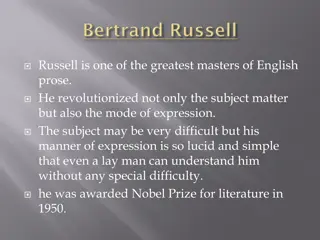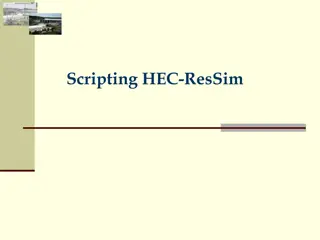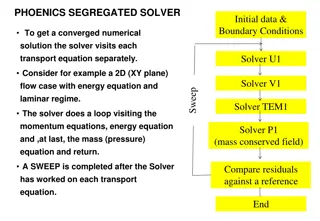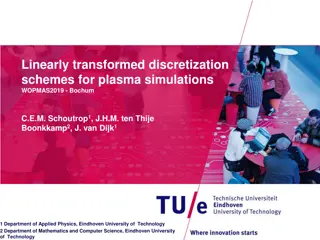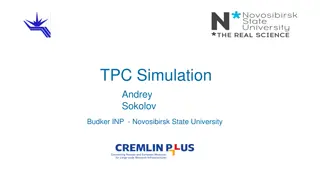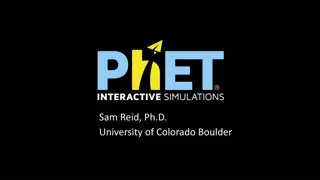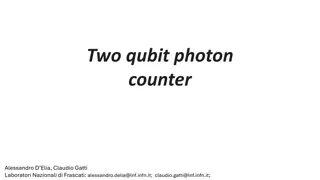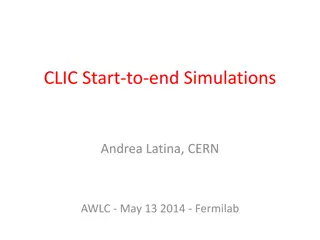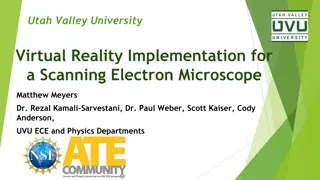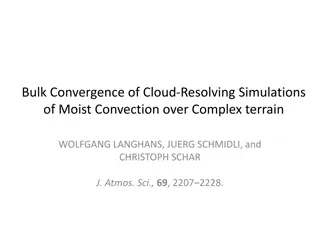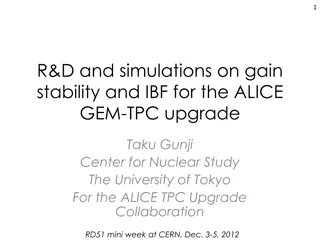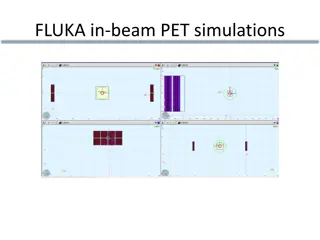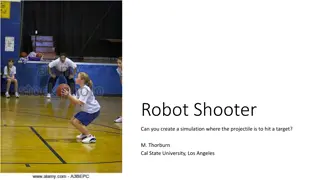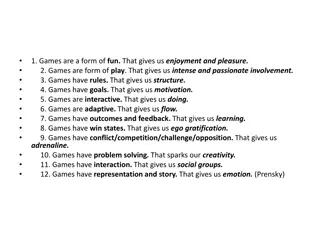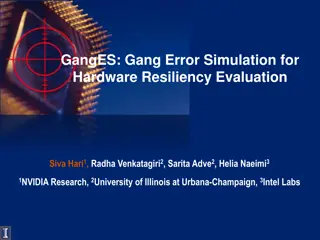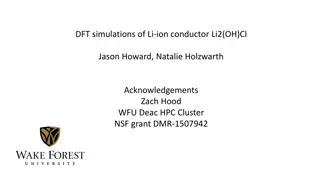Figures for AstroBEAR Simulations by Danny Russell
In this collection, various figures related to AstroBEAR simulations by Danny Russell are presented. The images depict wind velocity, magnetic field orientation, and setups with cylindrical brass obstacles. The future simulations outline the considerations for including radiative cooling. These visuals offer insight into the simulation scenarios being explored.
Download Presentation

Please find below an Image/Link to download the presentation.
The content on the website is provided AS IS for your information and personal use only. It may not be sold, licensed, or shared on other websites without obtaining consent from the author.If you encounter any issues during the download, it is possible that the publisher has removed the file from their server.
You are allowed to download the files provided on this website for personal or commercial use, subject to the condition that they are used lawfully. All files are the property of their respective owners.
The content on the website is provided AS IS for your information and personal use only. It may not be sold, licensed, or shared on other websites without obtaining consent from the author.
E N D
Presentation Transcript
In dentistry , the usefulness of x- ray depend on their ability to penetrate dental hard tissues . During production of x- ray , their are two types of wave lengths , long wave length and short wave length x x- - ray ) hard tissues , so not useful in diagnostic radiology thus removal of these long wave length photons from the beam by passing the beam through filter either built into the x- ray machine by manufacturer or added as an extra filter. long wave length and short wave length . The longer wave length x- ray (soft ray ) are not has the ability to penetrate the (soft filter made from aluminum aluminum , this filter
The effect of filtration on x- ray beam is absorption of most of long wave length photons , so the resulting x- ray beam will consist of mainly x- ray photons of short wave length with high energy photon and high penetrating power , so is called (hard x (hard x- - ray beam). ray beam).
Control the size and shape of x- ray beam . It made from lead with a hole in it's center used to control the size and shape of x- ray beam . The hole is either round or rectangular in shape . Rectangular collimation reduces patient exposure more than the round collimation because it produce a beam slightly larger than size of intra oral film . collimation can achieve by one of the following methods ; 1- Using diaphragms ( round or rectangular shape ) 2- Using metal cylinders , cone and rectangular tubes .
Diaphragm plate or disk made from lead , with a hole in the center of the disk allow the beam to pass through it only . The shape of x- ray beam determine by the shape of the hole of diaphragm such diaphragm is placed over the opening in the head of x- ray machine. Diaphragm : : consist of a metal
X X- -Ray Spectrum : x-ray beam consist of many photons of different wave length because : 1- electrons do not give up all their kinetic energy in identical shape . 2- potential voltage across the x- ray tube changes constantly as the AC Ray Spectrum : AC voltage varies to DC DC .
Inverse square low States that the intensity of x- ray inversely proportional with square of distance measured from the source of radiation to the point of measuring the radiation intensity : ( D) I X _____ D = Distance ( D ) ( (Intensity .) Inverse square low : : ( D)1 I = Intensity I = Intensity I X _____ D = Distance ( D )2 2 Intensity : :the number of photon per unit area
Rectification : The x- ray beam used in dentistry is not a continuo stream of radiation , but comes from the tube as pulses .The frequency of which depends on the number of cycle per second of Ac current . Half of cycle is (+) and other half is (-) , but for production of x- ray only the positive half of the cycle can be used to ensure that the electrons from the cathode filament are always drawn towards the anode target . Thus , the stepped up high voltage applied across the x- ray tube needs to be rectified to eliminate the negative half of the cycle . Rectification :
ex then 60 pulses of x- ray per sec . will be emitted from the tube . Each pulse of radiation last 1\120 sec . ,once there are no electrons at the anode to carry it across to the cathode .Thus the current is blocked from traveling in that direction . So , Rectification Ac ) to direct current ( Dc ) . A rectifier essentially eliminates the negative phase of Ac leaving the positive voltage to be as Dc . ex : if 60 cycle Ac current activates the tube , Rectification : : is the process of converting (
Definition of terms used in x interaction : Ionization from neutral atom Absorption removal of energy from the beam . Scattering photon with or without a loss of energy . Attenuation of x- ray beam caused by absorption and scattering . Definition of terms used in x- - ray interaction : ray Ionization : :removal of an electron Absorption : :deposition of energy , or Scattering : :change in direction of Attenuation : :reduction in the intensity
X- ray are absorbed by any form of matter (solid , liquid , and gasses ) . In dental imaging the x- ray beam : - enter the face of a patient - interact with hard and soft tissues - strikes a digital sensor or film * As the beam goes through the patient , it is attenuated *the x- ray photon are either - absorbed -scattered out of the beam -no interaction (9%) attenuated ( (reduced in intensity). reduced in intensity).
When photons reach on atom 4 things can happen : 1-Photon can pass through the atom without any thing change occurring to either the atom or the photon
2-It can be deviated from it's direction by the atom without any change in the atom , but the photon after deviation become a photon of scattered radiation (coherent scattering ) classical scattering (coherent scattering ) or ( ( classical scattering ) )
3-Photon can strike an electron of the atom and be completely absorbed, and this called (photo electronic effect ) condition , the electron of the atom is accelerated out of it's orbit and become photo electron , this photoelectron gives of it's kinetic energy by colliding with other electrons of other atoms or by interaction with nuclei of the atoms and producing electromagnetic radiation of long (photo electronic effect ) . .Under this
4- When x- ray photon hit an electron of atom and gives up only part of it's energy , this called (Compton effect ), electron that travel of high speed and photon that change it's direction , so photon become with low energy and long wavelength (Compton effect ), the result is an
X X- - ray measuring units 1 1- -Roentgen (R): x- radiation or gamma radiation which will produce in one cc of air ions carrying one electrostatic unit of either sign . 2 2- -rad dose 3 3- - rem equivalent does 4 4- -RBE: effectiveness does ray measuring units Roentgen (R): is the amount of rad : : it is a roentgens absorbed rem: : it is a roentgens RBE: is a relative biological
Central ray photons that traveling in the center of cone called central ray , and this is commonly used to fix and locate the position of x- ray beam . Primary Radiation emerging from tube head in a collimated useful x- ray beam Central ray : :in the beam x- ray Primary Radiation : : Energy
Secondary Radiation radiation resulting from interaction of primary beam of x- ray with matter , this secondary radiation consist of : scattered radiation of primary beam . Characteristic radiation . Leakage radiation from the tube head . Secondary Radiation : : Is the


